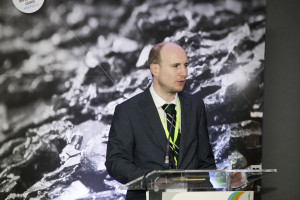
Patrick Wall
VERAM Coordinator
Patrick Wall holds a BSc in Chemistry and a MSc in Applied Environmental Science. With experience of working in the European Commission Directorate General for Research and Innovation and involvement in numerous FP7 and Horizon2020-funded projects over five years with EuroGeoSurveys, he now coordinates the VERAM project for the European Technology Platform on Sustainable Mineral Resources, for whom he also runs the Secretariat.
1. What are the challenges that Europe is facing in terms of raw materials and raw materials innovation needs?
VERAM aims to challenge the current compartmentalisation in scientific disciplines and fragmentation of research and innovation within the raw materials sector. This should help the various industry sectors involved in non-food, non-energy raw materials to increase synergies and facilitate the uptake of research results.
2. What is the role of VERAM in overcoming these challenges?
The project encourages capacity building as well as transfer of knowledge. The network formed within the VERAM project spans numerous stakeholders across the raw materials sector that would normally not interact at this level. By combining our views on future needs, we can map out a long-term research and innovation roadmap to address the most critical challenges that lie ahead.
3. How are you doing this?
To lay the foundations for the vision and roadmap for European raw materials towards 2050 we launched an online platform that gathers data on current and past projects in the area of raw materials, both at national and EU level (veram.eu). This contributed to a gap analysis. In addition, a wide-ranging study was carried out on the relevant players and their roles in the raw materials research and innovation network, looking at the current funding landscape and future scenarios. The vision for raw material research and innovation towards 2050 was built off this background work and gap analysis, along with an economic outlook and assessment of the capacity building needs across the sector. These led to the development of the draft roadmap, which is now released for wider stakeholder consultation.
4. What will be the impact of VERAM in the European context?
VERAM sees its European Research and Innovation Roadmap 2050 for Raw Materials as becoming a key reference to raw materials related R&I activities, paving the way for harmonised policies in the area of raw materials required by 2050. As a result, the Roadmap will embark upon activities to boost R&I and efficient industrial exploitation in the fragmented field of raw materials across Europe.
We as a community must ensure the needs we have outlined in the vision and roadmap are addressed by policy makers and research funding programmes, to bring about the envisioned benefits to both society and the European economy.
5. VERAM has received funding from EU’s Horizon2020 programme. What is the current scenario regarding funding for raw materials research in Europe and what can we expect?
The level of funding and recognition of the importance of raw materials R&I under Horizon2020 has been very encouraging and much needed progress is being made in the sector as a result. VERAM means to keep the momentum going and will be publishing its R&I Roadmap 2050 at the crucial moment when planning for the framework programme that succeeds Horizon2020 will be in full flight. Sustainability is a crucial aspect for the future security of raw materials in Europe – not just security of supply but of the industry itself and the workforce behind it (including production, processing, recycling, manufacturing, technology and service providers, etc.). With the next multiannual framework programme under development, we believe the VERAM project will offer significant impetus towards achieving a more sustainable future for raw materials in Europe.